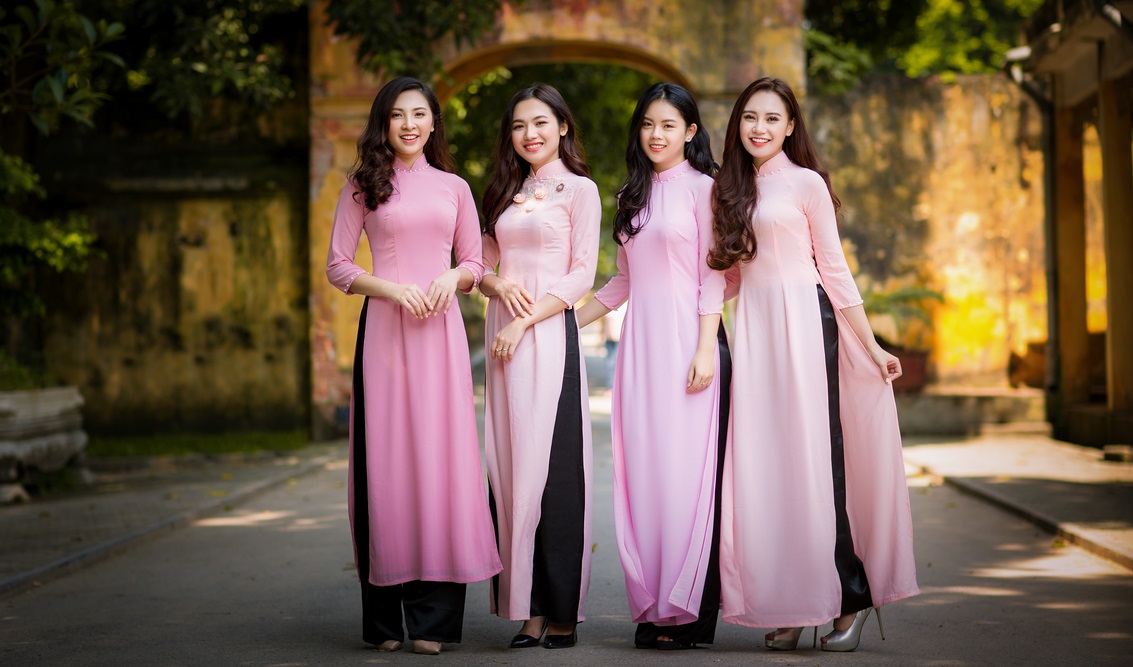The Vietnamese Ao Dai, a traditional and iconic garment, is a cultural symbol that beautifully encapsulates the spirit and essence of Vietnam. Characterized by its elegant, form-fitting design, the Ao Dai has a rich history dating back centuries and has become an integral part of Vietnamese culture, fashion, and identity. Its name, “Ao Dai,” translates to “long dress,” reflecting its distinct, slim silhouette. This garment embodies the nation’s deep-rooted traditions and its journey through time, evolving to adapt to the changing landscape of Vietnamese society.
The origins of the Ao Dai can be traced back to the early 18th century, during the rule of the Nguyen Lords in Hue, a city renowned for its refined culture. Initially, the Ao Dai was a more straightforward garment, consisting of a pair of trousers and a long tunic. Over time, it underwent significant transformations in both style and construction, turning into the quintessential two-piece ensemble known today. The modern Ao Dai consists of a figure-hugging long gown, usually made from silk or satin, with high slits up the sides for ease of movement. It is worn over a pair of flowing pants, creating a harmonious blend of traditional elegance and contemporary practicality.
The Ao Dai is not just a piece of clothing but a symbol of Vietnamese culture and identity. It represents the country’s rich history, with the elegant design echoing the grace and modesty prized in Vietnamese society. Wearing an Ao Dai evokes a sense of cultural pride and heritage, connecting the wearer to the long line of Vietnamese history. It has become an essential element in various aspects of Vietnamese life, from formal events to everyday wear. In schools, students often don the Ao Dai as a uniform, instilling a sense of discipline and cultural appreciation from a young age. For special occasions like weddings and cultural festivities, the Ao Dai is the garment of choice for both men and women, symbolizing unity and tradition.
What sets the Ao Dai apart is its versatility. It can be tailored to various lengths and styles, depending on the occasion. For casual wear, a knee-length or mid-thigh Ao Dai is popular among young women, offering a blend of modernity and tradition. For more formal events, the traditional ankle-length gown is favored, with intricate embroidery, intricate patterns, and vibrant colors. The beauty of the Ao Dai is that it can be customized to reflect an individual’s personality while adhering to the core principles of Vietnamese culture and aesthetics.
The Ao Dai is known for its timeless appeal, transcending fashion trends and remaining a beloved attire choice for Vietnamese people of all ages. Its ability to adapt to contemporary tastes while preserving its cultural essence has made it a symbol of national pride. Over the years, there have been modifications and innovations in Ao Dai designs. Designers have introduced variations in sleeve lengths, necklines, and embroidery patterns, catering to the diverse preferences of the modern wearer. Despite these adaptations, the Ao Dai’s inherent grace and charm persist, ensuring that it continues to be a cherished garment among Vietnamese people.
The materials used to create the Ao Dai are of utmost importance. Traditionally, silk has been the fabric of choice, exuding a luxurious sheen and a soft, smooth texture. However, as times have changed, other materials like satin and chiffon have also found their way into Ao Dai designs, offering more affordable options without compromising on elegance. Silk remains a symbol of prestige and opulence, making it the fabric of choice for special occasions and ceremonies. The intricate art of embroidery, known as “haute couture” in Vietnam, is another defining feature of the Ao Dai. The embroidery can be delicate and understated or bold and eye-catching, depending on the wearer’s taste and the occasion.
The colors and patterns used in the Ao Dai hold symbolic significance. Traditionally, white was reserved for older women, while young women and brides would opt for bright, vibrant colors like red. Today, there are no strict rules, and people choose colors that resonate with their personal style. Floral motifs, birds, and other nature-inspired patterns are popular in Ao Dai embroidery, reflecting the deep connection between the Vietnamese people and their natural surroundings.
Men also wear a version of the Ao Dai, although it differs in design and style from the women’s garment. The male Ao Dai typically consists of a long tunic paired with loose-fitting trousers, maintaining the essence of traditional Vietnamese attire. This masculine counterpart showcases the elegance and sophistication that the Ao Dai represents, making it suitable for various formal occasions, from weddings to cultural performances.
The Ao Dai has not only remained relevant in the fashion world but has also gained recognition on the global stage. In recent years, the garment has captured the imagination of fashion designers and enthusiasts worldwide. Its unique combination of simplicity, grace, and cultural significance has led to an increased demand for Ao Dai-inspired designs in international fashion. Celebrities and fashionistas have been spotted donning their versions of the Ao Dai, showcasing the garment’s enduring appeal and influence beyond Vietnamese borders.
One of the most iconic moments that elevated the Ao Dai to international fame was the “Ao Dai Diplomacy” campaign, launched by the Vietnamese government in 2014. This initiative aimed to promote the Ao Dai as a symbol of Vietnamese culture and identity on the global stage. Various international events and fashion shows have showcased the Ao Dai, bringing it into the limelight and sparking international interest. The Ao Dai has since made appearances on runways in Paris, New York, and other fashion capitals, solidifying its status as a global fashion icon with deep cultural roots.
The Ao Dai serves as a testament to Vietnam’s ability to preserve and celebrate its cultural heritage while embracing modernity. It’s not merely a garment; it’s a statement of identity, an emblem of grace, and a link to the nation’s rich past. Whether worn by young students or adorned by brides on their wedding day, the Ao Dai continues to weave its elegant presence into the fabric of Vietnamese society, ensuring that its legacy endures for generations to come. This magnificent garment represents the soul of Vietnam, where tradition meets innovation, and beauty is woven into every stitch and pattern.


Comment (0)